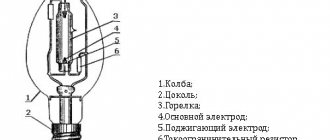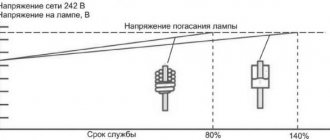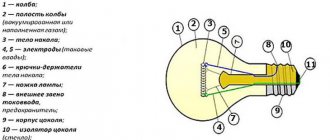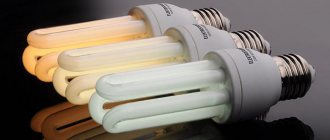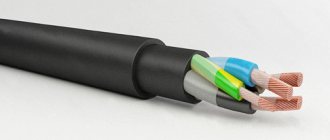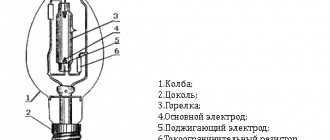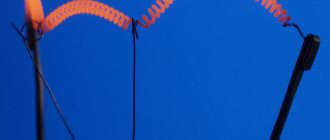The DRL electric lamp belongs to the arc mercury phosphor light sources, which create a luminous flux of significant power and at the same time have small dimensions. They have proven themselves to be excellent in organizing street lighting, as well as as lighting devices for industrial premises.
DRL type lamps
Design and operating principle
How a mercury discharge lamp works is shown in the figure.
Description of the symbols presented in the drawing of the design of a DRL type lamp:
- A – nickel-plated base E40 or E27 (the latter only for the DRL 125 model);
- B – resistor for limiting voltage;
- C – foil (made from molybdenum);
- D – additional electrode (igniter);
- E – frame;
- F – glass flask (yttrium vanadate is used to apply the luminomorphic coating);
- G-lead wire;
- H – main electrode (tungsten coated);
- J – nitrogen (used as a filler in the outer flask);
- K – mercury arc lamp;
- L – compressed junction of a quartz lighting source.
Devices of this type can be used in any premises, including fire hazardous ones, if they are installed in explosion-proof luminaires.
Design of the DRL 250 lamp
DRL is a lamp that consists of a base, a resistor, a limiting voltage, molybdenum foil, an electrode or an igniter. It also includes a frame, yttrium vanadate glass flask, lead wire, tungsten electrode, nitrogen filler, mercury arc lamp and compressed quartz junction. It is worth pointing out that in the first models there were only a few electrodes. But such a lighting device did not warm up well. As a result, it was necessary to have an additional starting element, namely pulse voltage. It did not allow the source to work efficiently and therefore it was soon replaced with a choke.
Glass flask
The glass bulb is the outer shell of the instrument. Inside it there is a quartz type burner, which has conductors coming from the base contacts. Almost all mercury and fluorescent arc lamps in use have a bulb from which air escapes and nitrogen enters.
Note! There are limiting conductor resistances in the additional electrode circuit. The inside of the flask has a phosphor layer
It is worth pointing out that for a modern lamp to work, only a choke is needed.
Base
The base is the simplest device that receives electricity from the network thanks to the contact of the current-carrying lamp and the contacts of the socket. The resulting electricity goes to the burner electrodes.
This is a structure that accepts the electrical network and has a threaded current-carrying part. The latter are connected by contacts and transmit electricity to the electrode elements.
Burner
The burner is the main functional element in the form of a quartz flask, which is equipped on both sides with two main and additional electrodes. Inside, the burner is filled with argon gas so that the heat exchange between the burner and the medium, a mercury drop, can be insulated. The outer flask contains a quartz burner of the lighting device, connected to the conductive elements thanks to a contact base. Also in the container is nitrogen with two resistance limiters connected to the electrodes and coated with a phosphor.
The first mercury fluorescent lamps had multiple electrodes. To ignite the lamp, it is necessary to additionally turn on the starting element or a high-voltage pulse breakdown between the burner. The more expensive DRL was removed from production and replaced with a four-electrode version. To ensure uninterrupted operation, you only need to use the throttle.
Principle of operation
After the supply voltage is applied, it is supplied through the base to the main and additional electrodes, which leads to the formation of a glow discharge between them. This leads to the formation of positive ions and free electrons in the flask.
After the number of charge carriers reaches a certain “threshold”, an arc appears in place of the glowing charge. As a rule, no more than a minute passes from the moment of switching on until the appearance of a stable arc discharge.
But the lamp will still need 7 to 10 minutes to reach working electrical and light indicators. This is due to the fact that a drop of mercury enclosed inside a gas-discharge device will need time to evaporate, after which a significant improvement in the brightness of the arc discharge occurs.
Note that the time to enter operating mode directly depends on the ambient temperature; the higher it is, the shorter this period of time.
Comparative review of LED and gas discharge lamps
The advantages of LED lamps are quite obvious.
High light output efficiency . The luminous flux of LEDs is about 100-120 lm/W. For comparison, with DRL this figure is only 30-35 lm/W.
The service life of LED light sources is about 50,000 hours, which is 5-6 times higher than their competitor.
Mercury lamps contain mercury, which requires special conditions for their disposal. Today, the production of lamps containing heavy metals is constantly declining. By 2020, it is planned to completely stop the production of such devices.
LED lamps require no maintenance at all.
If you initially install LED lighting when designing an object, you can significantly save on wiring, since the power requirements for power cables are much lower.
Luminous flux power. According to the passport data, mercury lamps have a slightly higher luminous flux, but the higher color temperature of LEDs visually eliminates these differences.
Change in luminous flux during operation . All gas discharge lamps decrease in brightness over time. After about three months, the luminous flux of the DRL decreases by 30%. The competitor's brightness remains virtually unchanged throughout its entire service life.
Device types
Lamps operating according to the principle described above are of the following types:
FRL – fluorescent mercury arc lamp;
Model HPL-N (Philips)
DRL lamps differ from DRL lamps in that they use a tungsten filament, which performs two functions: a light source and an electric current voltage limiter. To operate a device of this type, no special ballasts are required (throttleless electric lamp);
High pressure DRV devices (HQL), manufacturers Osram and Philips
DRLF – light sources that promote the process of photosynthesis in plants;
DRLF type device
DRUF and DRUFZ - emit in the long-wave ultraviolet spectrum;
Ultraviolet (bactericidal) electric lamp
DRT – tube-type ultraviolet light source;
Lighting source DRT
HPS - tubular lamps, in which, unlike DRL, in addition to mercury, sodium vapor is also used. The main feature is a specific shade of radiation (orange-yellow or golden-white), which requires special equipment to launch.
Mercury-sodium lamp DNAT
What is the product?
Mercury arc lamps are light sources that operate on optical radiation created by mercury vapor (their gas discharges). In today's world, such technology is very common. The scope of its application is different, for example:
Industrial facilities. These lamps have an excellent flow of light. In addition, they are resistant to adverse conditions. That's why they are popular in industry
Outdoor Lighting. Installation of such a lamp is appropriate on roadside poles, in squares and park areas. Also, such illuminators will perfectly illuminate the space along sidewalks and roadways. DRL street lamps perfectly withstand any temperature fluctuations and climate changes. A regular cobra goes well with mercury arc lamps.
Public places. Theaters, restaurants, etc. Here, such equipment will also create suitable lighting.
House. Such illuminators can also be installed in residential buildings. Even an ordinary chandelier is good under a DRL lamp.
However, most often mercury arc lamps are used on the streets. In the evenings, they provide comfort and safety to passersby. The DRL 250 model is especially popular, although DRL 125 and DRL 400 are also available.
Fluorescent-free lamp DRL 250
Specifications
We present the main parameters of the DRL and DVR types, as the most common.
The table shows the technical characteristics of DRL lamp models (125, 250, 400 and 700 Watt):
| Type | Power , W) | Starting current (A) | Operating current (A) | Voltage (V) | Luminous flux (lm) | life (h) |
| DRL-125 | 125,0 | 2,40 | 1,15 | 125 | 5900 | 12000 |
| DRL-250 | 250,0 | 4,50 | 2,13 | 130 | 13000 | 12000 |
| DRL-400 | 400,0 | 7,20 | 3,25 | 135 | 23500 | 15000 |
| DRL-700 | 700,0 | 12,00 | 5,40 | 140 | 40600 | 20000 |
Dimensions and type of base:
| Type | Base | Max Length(mm) | Max Diameter(mm) |
| DRL-125 | E27, E40 | 178,00 | 76,00 |
| DRL-250 | E40 | 227,00 | 76,00 |
| DRL-400 | E40 | 250,00 | 91,00 |
| DRL-700 | E40 | 292,00/355,00 | 122,00/152,00 |
Table characterizing the main parameters of DRV devices:
| Type | Base | Operating current (A) | Luminous flux (lm) | Power, W) | Service life (h) |
| DRV-160 | E27,E40 | 0,8 | 2500 | 160 | 4000 |
| DRV-250 | E40 | 1,25 | 4600 | 250 | 4000 |
| DRV-500 | E40 | 2,4 | 12250 | 500 | 4000 |
| DRV-750 | E40 | 3,5 | 22000 | 750 | 4000 |
Scope of application, advantages and disadvantages
DRL lighting devices are used to illuminate streets (in RKU, housing and communal services lamps, etc.) and large warehouses and production facilities, which is why they are also called industrial lamps. In addition, this type of light source is installed in a spotlight. The undoubted advantages of these devices include the following:
- high level of luminous flux;
- long service life (at least 12 thousand hours);
- Possibility of operation in cold weather;
- low price for ballasts for DRL type lamps.
Main disadvantages:
- due to the presence of mercury and phosphor, a special disposal technology is required (as required by the relevant GOST);
- low level color rendering (about 45%);
- dependence on the stability of the power source, namely, when the device is turned off, the lamp will not light, and the one that is on will go out if the voltage “drops” by 15-20%;
- at negative temperatures below -20° C, the lighting source may not ignite; in addition, under such operating conditions, its service life is significantly reduced;
- restarting is possible only after 10-15 minutes;
- after a certain period of operation (usually about 2000 hours), the level of luminous flux decreases significantly.
The scope of application of DRV lighting devices is almost the same as DRL, but if we compare these two types, the former have the following advantages:
- operation does not require special equipment (PRU and IZU devices), which reduces the cost of installation and installation;
- the ability to use instead of a conventional incandescent light bulb;
- high light output;
- low cost.
The disadvantages characteristic of this type include:
- low efficiency, almost half that of a DRL lamp;
- short service life (about 4000 hours).
Area of use and service life
Such lamps are often used to illuminate streets or underground passages, as well as industrial and manufacturing enterprises, plants and factories. In addition, they are widespread in rooms where there are almost never people. In them, the requirements for color rendering are low, and the requirements for energy conservation are extremely high. This is where DRL 400 shows itself.
You may be interested in this: How to calculate grounding
DRL is often used in uncrowded places
For your information! Regardless of the power of the lamp, its service life depends on the characteristics laid down by the manufacturer and the components he uses. Usually it starts from 4000-5000 hours, but it can easily reach 10-15 thousand hours.
Connection
The connection diagram for DRL lamps is shown in the figure; note that the functionality of these lighting sources can only be checked by turning them on accordingly.
Connection diagram for mercury arc light source
Symbols on the diagram:
- EL1 – DRL device;
- C – non-electrolytic type capacitor (must be designed to operate with a voltage of at least 250V), serves to reduce electricity consumption by reducing reactive power;
Video: Connection diagram of the inductor to the DRL lamp
- L1 - throttle;
- F1 – fuse.
Each type of lamp needs a corresponding choke, its task is to reduce the current of the power source, connecting it directly will lead to their failure.
Photo of chokes
The capacitor capacity is selected according to the following table:
| Light source power (W) | Capacitor capacity (uF) |
| 125 | 12,0 |
| 250 | 25,0 |
| 400 | 32,0 |
Chokeless lighting devices (DRL), unlike DRL lamps, do not require a special switching circuit.
How to properly connect a DLR 125 lamp
There are two methods for connecting the DRL 125. This can be done with or without a choke. These two methods are described in detail below.
Throttle
This connection diagram is quite easy and involves a serial connection of the inductor circuit and the DRL 250 light bulb itself. The connection is made to a 220 volt network and operates at a classic frequency. Therefore, it is very easy to connect such light bulbs to your home network.
The throttle will act as a stabilizer and corrector of the work process. Thanks to it, the light bulb will not flicker, it works constantly, and the light beam does not change when the incoming voltage fluctuates.
Connection diagram via inductor
Attention! Connection without a choke is impossible, because the product will burn out instantly. To operate, the circuit must be powered by a sufficiently high voltage, which from time to time reaches a level equal to three or four incoming voltages
To operate, the circuit must be powered by a sufficiently high voltage, which from time to time reaches a level equal to three or four incoming voltages.
No throttle
If you need to use the DRL 125 light bulb model as a regular device without using a classic choke, then it can be connected using professional technology.
The easiest connection method would be to purchase a special light bulb that can function without a choke. It is equipped with a special burner that acts as a stabilizer and can dilute the light beam. But this connection method is not recommended for a person without electrical skills. It is very complicated, so it is better to seek help from a professional.
Connection process
You must also remember to properly store and dispose of these lamps. Since they contain a small percentage of mercury, such lamps should not be thrown into the trash or kept in a bag. Used devices must be taken to a recycling facility (they can be found at hardware stores). Unused lamps should only be stored in cardboard boxes, away from children and animals. If the DRL 125 is broken, then the first thing you need to do is ventilate the room, and then do a wet cleaning.
Many electricians do not recommend installing such light bulbs in houses or apartments. They do not illuminate the room sufficiently and are also hazardous to health. Such devices are only suitable for street use or in warehouses.
Proper storage
DRL 125 light bulbs are perfect for lighting courtyards, streets, verandas or parking lots. You can simply connect them yourself using a choke
But, of course, it is important to follow all safety rules when working.
Alternative lighting sources
An energy-saving LED lamp is an excellent analogue to other lighting sources, including DRL; if you buy it, you can significantly save on electricity. Replacing street lighting will pay for itself after three years of operation, even taking into account the refurbishment work.
Many well-known foreign and Russian companies (for example, Lisma) are engaged in the production of these lighting devices. Currently, the price of these devices is slightly higher than the cost of a DRL lamp, but in the near future this problem will be eliminated, which will make LED lighting sources more accessible in Moscow, St. Petersburg, as well as in cities such as Saransk or Yekaterinburg.
How to properly connect a DRL 400 lamp
If you want to connect the DRL as a lamp without using a special choke, you will have to resort to other methods. The easiest way is to purchase a special DRL foot, which will work normally without a throttle. Such samples use a special spiral that works as a stabilizer.
Important! If you use a regular DRL lamp without a choke, it will burn out instantly, since the voltage to start it can be very high. You can remove the inductor by adding several capacitors to the overall design
It is important to correctly calculate the current they produce.
For all its shortcomings, DRL is a good lamp for certain tasks
Thus, the DRL 400 light bulb was considered, which has found its wide use in industrial premises, on the streets and in uncrowded places. Using it precisely in these conditions, you can win significantly.
